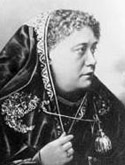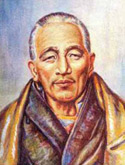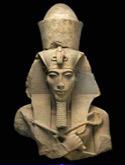Baruch Spinoza (the “Gentle Philosopher”, the “God-intoxicated Philosopher”)
December 4, 1632, Amsterdam, Holland, 4:00 PM, LMT.
(Source: Marc Penfield who references Matthews who gave Spinoza Gemini rising). Died, February 21, 1677
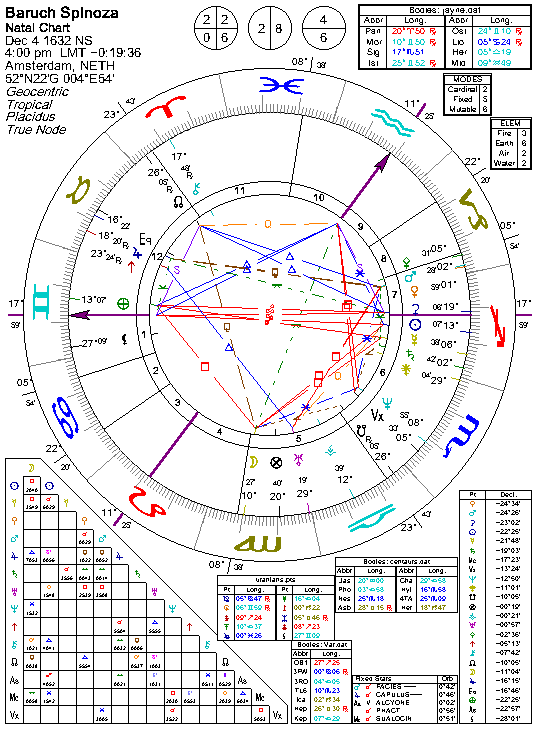
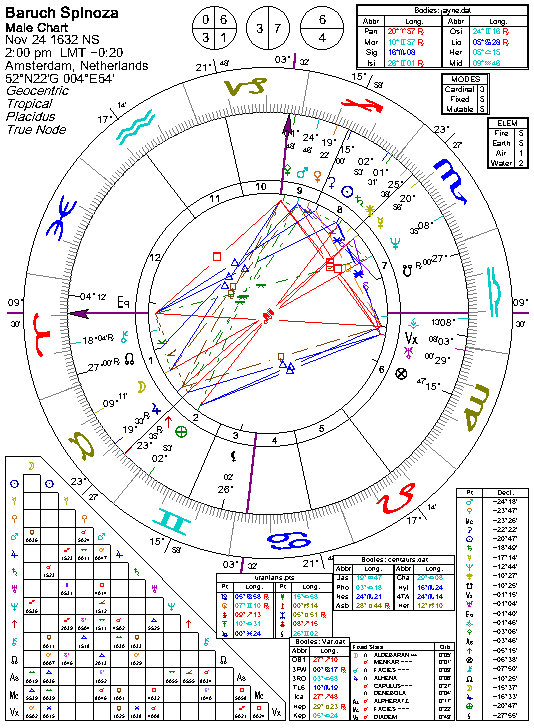
(Chart Referenced: Ascendant, Gemini; Sun in Sagittarius, with Mercury conjunct Saturn also in Sagittarius; Moon and Uranus in Virgo; Venus conjunct Mars in Capricorn; Jupiter conjunct Pluto in Taurus; Neptune in Scorpio.)
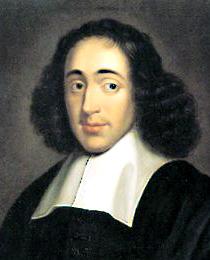 Again we are faced with the possibility of two or, perhaps, three charts. A date of November 24, 1632 is sometimes suggested , but it is uncertain whether this date is to be interpreted in the Old Style which would convert it to December 4, 1632, New Style (a date also frequently used and the one which will be used in the present interpretation). The New Style positions for December 4, 1632 and the Old Style Positions for November 24, 1632, 4:00 PM are as given above. The New Style positions for November 24, 1632, 2:00 PM are as given immediately below:
Again we are faced with the possibility of two or, perhaps, three charts. A date of November 24, 1632 is sometimes suggested , but it is uncertain whether this date is to be interpreted in the Old Style which would convert it to December 4, 1632, New Style (a date also frequently used and the one which will be used in the present interpretation). The New Style positions for December 4, 1632 and the Old Style Positions for November 24, 1632, 4:00 PM are as given above. The New Style positions for November 24, 1632, 2:00 PM are as given immediately below:
(Alternative Chart not Referenced: Ascendant, Aries: Sun in Sagittarius conjunct Saturn also in Sagittarius; Moon in Taurus; Mercury in Scorpio; Venus conjunct Mars in Sagittarius; Jupiter conjunct Pluto in Taurus; Uranus in Virgo; Uranus in Virgo; Neptune in Scorpio.)
(Another alternative chart could be erected with Gemini on the Ascendant for the earlier date, November 24, 1632. Such a chart is suggested by Marc Penfield in his An Astrological Who’s Who, 1972, and shows the last degree of Gemini rising. When Penfield published his Penfield Collection in 1978, he utilized the December 4th date, and changed the Ascendant in Gemini from the 30th degree to the 18th degree. It is this latter chart which will be used as the basis for the interpretation.)
The author has done his best to compare these charts to Spinoza’s character and to the events in his life. The December 4th chart, NS, was chosen for the following reasons.
- Immediately before his mother’s death in late 1638 or early 1639 there was a solar eclipse (on December 5, 1638) in the very same degree as Spinoza’s Sun in the December 4th natal chart. The Sun is ruler of the IC in all Gemini rising charts for Spinoza, and, therefore, rules the “mother”.
- Immediately before his own death which occurred on February 21, 1677, there was another solar eclipse (on December 5, 1676) which occurred within just a degree of Spinoza’s Sun in the December 4th natal chart. The fourth house rules, among other things, the “end of life”.
- These two very similar eclipses were decisive in his life and would not have touched any such significant points in the chart erected for November 24th, New Style, for the Sagittarius Sun would have been in only the third degree.
- The rigor and exactitude of Spinoza’s rationalistic thought are characteristic of a conjunction between Saturn and Mercury (in Sagittarius). This conjunction occurs only in the December 4th chart.
- Spinoza died of tuberculosis, apparently aggravated by his inhaling glass dust from lens grinding. In the 4:00 PM chart for December 4th, Saturn in Sagittarius is placed in the sixth house (ruling his occupation—not his true philosophical career or vocation). Saturn is the ruler of the eighth house, the house of death. This placement, therefore, shows the cause of death as related to his occupation or employment. This is not the case with the chart usually offered for the November 24th date—a chart with Aries rising and Saturn in the eighth house.
- Further, in the Gemini rising charts, the December 4th chart shows a conjunction between Saturn and Mercury—Mercury being the orthodox ruler of the Gemini Ascendant. Mercury and Gemini are associated with the lungs and Spinoza died of a lung affliction. In the earlier Gemini rising chart (for November 24th), Saturn and Mercury are at least eleven degrees from each other—too wide for a conjunction. The cause of death as tuberculosis is far more accurately reflected by the Saturn/Mercury conjunction (with Saturn as the bringer of affliction)—especially since Sagittarius, in which they are both found, since it is the sign reciprocal to Gemini, is often involved in lung ailments.
- Spinoza developed considerable expertise as a lens grinder. The Virgo Moon of the December 4th chart is more suggestive of this skill. Additionally, Mars and Venus have moved into Capricorn in this later chart. These three earth signs suggest something of the exactitude required for mastery of such a craft—much more so than a Taurus Moon and Mars and Venus in Sagittarius (in the November 24th chart).
- The Aries rising chart of November 24th does not correlate well with the character of the “gentle philosopher”, who, it appears, ever sought to avoid confrontation (even with the elders of the Jewish Synagogue who unjustly accused him of blasphemy and heresy).
- The extensive correspondence which Spinoza carried forward, correlates far better with a Gemini Ascendant and a Sun near the seventh house cusp than with the Aries Ascendant.
- The Virgo Moon, found only in the December 4th chart, seems suitable for Spinoza’s retiring way of life and bachelorhood. Further, when his father died in March of 1654, there was a lunar eclipse (on March 3, 1654) two degrees from the Virgo Moon. There was property dispute as a result of this death, and the Moon, implicated by eclipse, symbolizes property, and is the ruler of the third house in the December 4th chart. The dispute was with one of Spinoza’s siblings (siblings are ruled by the third house)—his stepsister. Another solar eclipse about six months before the father’s death occurred within twenty minutes of arc of Spinoza’s Uranus position. In the Gemini rising chart of December 4th, Uranus is the ruler of the Aquarius MC, indicating the (sudden?) loss of the father.
- Most convincing of all for the chart with the 18th degree of Gemini rising is Spinoza’s excommunication from the Jewish Synagogue in July of 1656. Again two solar eclipses are involved—one in the 10th degree of Leo about a year before the excommunication and another in the 7th degree of Aquarius about six months before this determining event. The Aquarius/Leo MC/IC in the December 4th Gemini chart was, therefore, implicated—though the “hit” was not exact.. Nothing would be touched in the Aries rising chart of November 24th.
- Further, and most impressively, Pluto which is the planet ruling excommunication, expulsion and exile was making a transit across the ascending degree (the 18th degree of Gemini) exactly at the time of the excommunication. In addition, after that expulsion from the synagogue, he was banished (Pluto) from Amsterdam for a short time by the civil authorities. All of this most certainly points to the validity of a Gemini rising chart, as Pluto had passed the opposition of his Sagittarius Sun some two years before, and nothing so dramatic had occurred. The Gemini rising chart for December 4th is far more convincing than the a Gemini rising chart for November 24th.
Life and Chart Analysis
Benedict (Baruch) Spinoza was one of the world’s great philosophers. He was both a rigorous rationalist and a pantheist, seeking to understand the world by the Euclidean method, reasoning deductively from self-evident axioms and carefully formulated definitions to profound conclusions concerning the nature of God, Man and human society.
Since his death in 1677, Spinoza has at various times been both in and out of favor. The period of particular disfavor occurred for about a century after his death, during which times his ideas were widely considered as blasphemous. A skeptical critic, Pierre Bayle called Spinozism “the most monstrous hypothesis imaginable, the most absurd”. David Hume, a Scottish Skeptic, empiricist and historian, referred to the “hideous hypothesis” of Spinoza.
Yet, no lesser minds that the great German initiate poet, novelist, and scientist, Johann Wolfgang von Goethe, as well as dramatist and critic G.E. Lessing, and the poet Samuel Taylor Coleridge found in Spinoza much to admire—an intensely spiritual understanding of reality yet divorced from all religious dogma.
Spinoza has been called the “gentle philosopher” and the “God-intoxicated philosopher”. A man of modest and retiring habits, he had a profound effect upon some of the foremost thinkers of the seventeenth century and his influence has continued to grow in philosophical circles, especially since the early 19th century. Spinoza became so popular with unusually diverse groups of philosophers partially because it was possible to read into his works a support for such widely contrasting world-views as atheism, materialism, pantheism, absolute idealism, and empiricism, to name only a few.
That so many antagonistic schools of thought could find a resonance with Spinoza’s philosophy gives some idea of the breadth and depth (and perhaps, the essential obscurity) of Spinoza’s lucidly-articulated ideas.
Spinoza’s principle works are the Ethics (1665), the Short Treatise on God, Man, and His Well-Being, the Treatise on the Correction of the Understanding, the geometrical version of René Descartes’ Philosophical Principles, A Treatise on Religious and Political Philosophy (1670), and Posthumous Works, including the Treatise on the Improvement of Understanding, Letters, and Hebrew Grammar.
Spinoza belonged to a group of Jews who fled the Inquisition from Spain and Portugal. His family settled in Holland, which after its successful revolt from Spain adopted a policy of religious toleration. Spinoza was educated in the orthodox Jewish manner, but studied Latin, absorbed the works of the significant philosophers, especially Thomas Hobbes and René Descartes, and received a thorough schooling in scholastic theology and philosophy.
He emerged as an independent thinker which led him into constant conflict with the authorities of the Jewish Synagogue of Amsterdam. After threats and bribes failed to silence him, he was excommunicated from the Synagogue in July, 1656. He abandoned his Hebrew name, “Baruch”, and chose the Latin name, “Benedict”.
Apart from his philosophical pursuits, Spinoza became a lens grinder of great skill (Moon in Virgo and the presence of the fifth ray). Some suggest that he undertook this occupation of necessity in order to make a living, but others see him pursuing a scientific interest in optics. Apparently he was also supported by a series of grants, pensions and bequests which made it possible for him to pursue his interest in philosophy.
Spinoza lived a modest and retiring life. He had numerous friendships with the philosophically and scientifically minded, and shared his writings within these circles; he dared not publish them for fear of the authorities—civil and religious. Only one of his books (A Treatise on Religious and Political Philosophy) actually was published under his true name during his lifetime.
Spinoza maintained a wide correspondence (Gemini Ascendant) and was visited by many philosophers, the distinguished Gottfried Wilhelm von Leibniz among them. A few years before his death he was offered a professorship at Heidelberg, but he preferred his quiet life and especially the freedom of thought which it afforded him.
He contracted tuberculosis (Gemini/Sagittarius axis, with Mercury conjunct Saturn) and his condition was apparently aggravated by his inhalation of glass dust from the grinding of lenses. He died on February 21, 1677, leaving instructions for the posthumous publication of various of his works—under his own name.
Spinoza’s Metaphysics: Spinoza philosophy was rationalistic, deductive and monistic (i.e., characterized by the hypothesis of one fundamental substance). Deductive rationalism is characteristic of the third ray (the Ray of Abstract Intelligence); Monism suggests the presence of the inclusive second ray of Love-Wisdom. Spinoza shared with Descartes an intensely mathematical appreciation of the universe, though he differed with Descartes on certain fundamentals.
Whereas, for Descartes, mind and body were two different substances, for Spinoza there was but one substance of which mind and body could be considered different aspects. He called this substance both “God” and “Nature”. He conceived the universe as a single substance capable of an infinitude of attributes (hence his pantheism). “God is a Being infinite in an infinite number of ways”. The universe can be known by two of these attributes especially—“extension” (the major property of matter) and “thought”, (the major property of mind). God is not seen as a supernatural Entity in contradistinction to Nature; God and Nature are one. God is Nature in its fulness.
Although Spinoza was a rationalist, he was, unlike a number of the absolute idealists, also an empiricist. He was a close observer of Man and Nature. He studied physical experiences in order to produce “adequate ideas” which, in his view, depended upon a coherent, logical association of perceived physical experiences. His belief in observation and empiricism was, it might be said, out-pictured in his secondary occupation—that of lens grinding. He interest was in how things are seen. His respect for empiricism and his deepening understanding of optics both speak for the presence of the scientific fifth ray in his ray formula.
In his most famous and revolutionary work, the Ethics, Spinoza explores the concepts of freedom, bondage and free will. In many ways, Spinoza is a determinist, seeing the universe as a mechanistic system, and taking issue with the existence of free will (either for God or Man).. The principle of necessity (Saturn is conjunct Mercury and is dispositor of his Venus/Mars conjunction) is of determining importance in his thought. All beings seek to maintain and express the power of their being, and thus virtue and power are one.
But for Spinoza, power derives from a knowledge of necessity. When powerful or virtuous persons act, they understand why they must act. They are free only in their understanding. What they must do, they cannot escape doing, but, because the have “adequate ideas”, they are aware of the necessity of so doing.. Those, on the contrary, who are not free, act without awareness of the law of their being (i.e., they are driven to act by instinct and do not understand why they must act or how they must act). Man is rigorously compelled and determined, but some human beings see and know what is happening to them (and are thus free—at least, in consciousness) and others do not see and know, and hence are enslaved.
The free individual is guided by the laws of his own nature. Those so guided are never out of harmony with others similarly guided because the true law of one’s nature is never at variance with the true law of another’s. Always there is an inescapable conformity to law, and no possibility of evading the law of one’s nature. The person in bondage is moved by causes which he does not understand or about which he is confused.
For Spinoza, there is no distinction between will and reason. Ideas cannot be passively entertained and later put into action. Ideas, and not will, are the causes of action. By equating idea with power and virtue, and thus discounting the will as an independent agency, Spinoza displays his third ray bias. The third ray exalts the mind above all other faculties. Thus, for Spinoza, the clear and reasonable mind is the cause of all correct action. Will is subsumed into mind. Indeed, in Spinoza’s ray makeup, the first ray is deficient, and his view of the process of willing and thinking reflects this deficiency.
In the realm of political philosophy, Spinoza shares with Thomas Hobbes a number of similarities, but their conclusions are very different. Both identify the reality of the “social contract”. Right is seen as relative, and the social contract proves binding only as long as it serves the advantage of the participants. But for Hobbes, strongly influenced by Aries, Taurus and a greater intensity of the first ray, advantage lies in satisfying as many desires a possible. Hobbes was the more materialistic thinker. For Spinoza (focussed upon the Sagittarius/Gemini axis) advantage is found is escaping from those desires through understanding. Spinoza’s is the more detached view.
To clarify Spinoza’s view of man’s social possibilities, it can be said that Hobbes does not imagine a community of individuals whose desires can be consistently satisfied, so the use of force or repression is always necessary; Spinoza, however, more benign in his imagination, can foresee just such a community and such consistent satisfaction, so, in his political and religious thought, the notion of freedom, especially freedom of inquiry (Gemini, Mercury, fifth ray), is of fundamental importance. Again, we see a somewhat detached mind at work, perhaps naïve in its estimation of the ease with which man’s instinctual nature can be managed.
The November 24th chart, shows an Aries Ascendant, like that of Hobbes, and a Taurus Moon (Hobbes also had a strong stellium of four planets and two asteroids in Taurus). This kind of chart does not seem correct for the “gentle philosopher”, so detached from his well controlled emotions (Moon in Virgo). Spinoza is capable of ‘mentalizing’ the life process, and seeks freedom from the bio-psychic compulsions; Hobbes seems rather more in their grip. Thus, again, the later chart for December 4th, emphasizing Gemini and Virgo (Sagittarius remains the same) seems more suitable.
With this woefully brief summary of Spinoza’s philosophy and some knowledge of his life process, we can offer a speculative hypothesis regarding his rays.
Monad: Ray Two
Soul: Ray III
Personality: Ray 2
Mental Vehicle: Ray 5
Astral Vehicle: Ray 2
Physical Vehicle Ray 7
Perhaps it is not possible to gain a good idea of the ray of Spinoza’s monadic vehicle. The overall impression of his energy system is that it offers a mixture of rays two and three. Spinoza, as one of the greatest of philosophical minds, may well have stood at an evolutionary point where the ray of the monad could be considered influential. There is much to suggest that he was an initiate of the third degree or, at least, very nearly at that stage. His profound love and respect for geometry connects him to that Ray Lord Who is known as “The Grand Geometrician” — the Ray Lord of the second ray.
The following quotation from The Secret Doctrine contrasts Leibniz’ and Spinoza’s views with respect to ultimate reality—(for us) the realm of the monad.
“The student must now be shown the fundamental distinction between the system of Leibniz* and that of occult philosophy, on the question of the Monads, and this may be done with his Monadology before us. It may be correctly stated that were Leibniz’ and Spinoza’s systems reconciled, the essence and Spirit of esoteric philosophy would be made to appear. From the shock of the two — as opposed to the Cartesian system — emerge the truths of the Archaic doctrine. Both opposed the metaphysics of Descartes. His idea of the contrast of two substances — Extension and Thought — radically differing from each other and mutually irreducible, was too arbitrary and too unphilosophical for them. Thus Leibniz made of the two Cartesian substances two attributes of one universal unity, in which he saw God. Spinoza recognised but one universal indivisible substance and absolute ALL, like Parabrahman. Leibniz, on the contrary perceived the existence of a plurality of substances. There was but ONE for Spinoza; for Leibniz an infinitude of Beings, from, and in, the One. Hence, though both admitted but one real Entity, while Spinoza made it impersonal and indivisible, Leibniz divided his personal Deity into a number of divine and semi-divine Beings. Spinoza was a subjective, Leibniz an objective Pantheist, yet both were great philosophers in their intuitive perceptions”. (SD Vol. I, 629)
Spinoza was, in HPB’s words a “subjective Pantheist”, and Leibniz, an “objective Pantheist”. Here, it can be argued, we see the difference between a profoundly unitive second ray and the profundity of the ray of multiplicity and discrimination—the third. Both philosophers sought to overcome the “Cartesian split”, but Spinoza had recourse to a “universal, indivisible substance and absolute ALL, (in HPB’s words) like Parabrahman”, and the other, more influenced at a fundamental level by the third ray, believed in an “infinitude of beings”.
Like Plato and Aristotle, the truth lies in the combination of perspectives—Plato representing more the second ray and Aristotle the third. There is something Neptunian about the tendency to dissolve all multiplicity into a single substance, and indeed, Neptune is prominent in the December 4th, 4:00 PM chart, conjunct the Vertex in Spinoza’s chart for December 4th. .
Conduits for the second ray in Spinoza’s astrological chart are several. Firstly, if Gemini is the Ascendant (as can be reasonably hypothesized), then the second ray is strongly represented. Further, if we speak of monadic influence with respect to the second ray, the point opposite the Sun (considered by the author as the “monadic point”) would be found in second ray Gemini, and would therefore be an important point of entry for second ray energies related to the monad. This does not mean however, that all monadically sensitive individuals with a Sagittarius Sun (and thus a monadic point in second ray Gemini) would necessarily have a second ray monad, just as the ray or rays distributed by the soul-oriented Ascendant do not necessarily reveal the ray of the soul.
Anther conduit for the second ray is the Moon in second ray/sixth ray Virgo. The Moon is the esoteric ruler of Virgo and veils either Vulcan or Neptune. Spinoza’s pervasive, gently unitive (rather than ardent) mysticism makes the veil of Neptune more likely, though for a highly advanced and mental individual, Uranus must always be considered in relation to the veiling Moon. In Spinoza’s chart, Uranus, as it happens, is in Virgo relatively close to the Moon, with the Part of Fortune at the midpoint between the two.
Still another second ray conduit is second ray Jupiter found in the second sign, Taurus. Jupiter, as the orthodox ruler of the Sagittarius Sun sign, is a powerful planet. Placed in Taurus, it emphasizes the Wisdom rather than the Love aspect of the second ray.
Jupiter is also closely parallel to one of the alternative Ascendants—the Equatorial Ascendant. As well, Jupiter is found in the twelfth house, a mansion in which it is accidentally dignified and friendly to the expression of the second ray, for the sign most correlated with the twelfth house is Pisces, which distributes the second ray as well s the sixth.
Spinoza’s soul ray (a subray of the monadic ray) was very probably the third, which inclined him him, initially, to identify so strongly with the thought of René Descartes, to the point that Spinoza re-systematized and presented in a more geometrical form Descartes’ Principia. His connection with another great third ray soul, Gottfried Wilhelm von Leibniz was also profound. By one’s deep affiliations on the physical plane, the ray of the soul can be reasonably estimated.
Spinoza was a rationalist and ‘deductivist’—approaches to thought supported by the reasonable and reasoning third ray rather than the more strictly empirical fifth ray, or the more intuitive second. Of course, any thinker on any ray can use deductive, empirical/inductive or intuitive means, but the preponderance of emphasis indicates the preponderant ray quality.
Further, the emphasis upon necessity, conformity to law, and lack of free will relates Spinoza to the Saturnian aspect of the third ray. Mercury as well as Saturn distributes the third ray (Mercury, probably, in its planetary personality nature), and Sagittarius (in which these two planets are found conjuncted) is the third fire sign much associated with the third aspect of the spiritual triad—the higher mind. Seen in this way the Mercury/Saturn conjunction in Sagittarius represents a powerful third ray focus (though it would also strengthen a concrete mind upon the fifth ray).
Further, Spinoza’s historical emphasis in Biblical interpretation and criticism links him to the historical third ray. He was a thoughtful enemy of unwarranted credulity (so often found upon the sixth ray). His freedom from both religious dogmatism and blind faith, however, were not the effect of the third ray alone (which when combined with the sixth can, indeed, be dogmatic), but were equally caused by the probable absence of the sixth ray in his ray makeup (regardless of power of sixth ray Sagittarius), and by the strong representation (on possibly three levels—monadic, personal and astral) of the second ray of Love-Wisdom.
Spinoza placed a strong emphasis upon intelligibility. For him the doctrine of free will (whether ascribed to Man or to God) rendered the world unintelligible. He therefore repudiated the presumed freedom of a transcendent God and with it, the free will of Man.. He, therefore, espoused a variety of exacting determinism frequently found when the third ray conditions the thought process.
As well, he was dissatisfied with the informality of exposition characteristic of his first two works. In his search for rational, deductive rigor, he was responding to the thought-systematizing tendencies of the third ray, supported by the fifth and seventh. This rigorous approach is truly characteristic of the reasoning Saturn/Mercury conjunction. His purpose was to present metaphysics deductively, that is, as a series of theorems derived by necessary steps from self-evident premises expressed in terms that are either self-explanatory or defined with unquestionable correctness. In this approach we can surely see how much he blended the third and fifth rays.
Third ray conduits in Spinoza’s astrological chart are found in relation to the sometimes third ray sign, Capricorn (containing a conjunction of Mars and Venus) and also through Gemini (the third sign), and through Virgo (like Gemini ruled by sometimes third ray Mercury, and, itself, identified with the third or matter aspect). As previously stated the Saturn/Mercury conjunction in Sagittarius can also represent a third ray center of focus.
The second ray seems the appropriate ray for the personality of this “gentle philosopher”. He was mentally bold, but personally retiring and inoffensive. Often he was employed as a teacher or tutor, frequently gathering through his magnetism a study circle around him. His method was one of accommodation. When, at his father’s death, his stepsister sought to claim the entire inheritance, he entered a law suite (which he won), only to let her keep nearly everything. This is characteristic of the kind, second ray personality, and hardly consistent with the possibility of an Aries Ascendant.
Spinoza’s interest in optics and, in general, in the science of the day relates him to the fifth ray—the “Ray of Science and Concrete Knowledge”. It has already been noted that he embraced the value of empiricism (while keeping it as a subset of third ray rationalism). Empiricism is also motivated the fifth ray. Sagittarius conveys the fifth ray, and the Virgo Moon and the Mercury/Saturn conjunction can reinforce its exacting, discriminating tendencies. Fifth ray Venus is the esoteric ruler of the hypothesized Gemini Ascendant, and is placed in Capricorn, a sign friendly to the power of the discriminating mind.
The Venus in Capricorn position must be noted in relation to the possibility of the third initiation (which it rules). That initiation is ruled by the fifth ray and Capricorn, Venus is, thus, hierarchically placed, offering to those capable of fulfilling its potential, the possibility of intense illumination. Spinoza was capable. His doctrine of substantial monism was his own way of revealing unity—the task of every disciple who aspires to the third degree or has achieved it.
On a more objective level, Spinoza’s method of thought is clear, lucid and logical. Throughout his work, he explicitly or implicitly emphasizes the value of definition (the province of the fifth ray), and is at pains to define with precision so that his deductive method can be maximally fruitful. As well, the practicalities of lens grinding and polishing certainly must have demanded the fifth ray (plus the seventh) if the task were to be successfully accomplished. He was, after all, an expert in the craft. As well, his ongoing search for what he called “clear and distinct ideas”, certainly suggests the presence of the fifth ray.
The seventh ray (entering especially through Capricorn) can be inferred because of his apparent physical delicacy, his modesty, quietude, and also his practical work with optics. The orderly and logical presentation of his Ethics also suggests the ordering quality of the seventh ray.
Turning more specifically to Spinoza’s astrology, we find his Sun, Mercury and Saturn all in Sagittarius. In many ways, Sagittarius is the philosopher’s sign, and also that of the seer. His interest in vision and optics is, thus, partially related to this sign. Sagittarius is also related to the quest for pure truth—especially when combined with the second and third rays (the philosophical rays).
For Spinoza, the wisdom that philosophy seeks is achieved when one perceives the universe in its wholeness, through the “intellectual love of God,” which merges the finite individual with the eternal unity and provides the mind with the pure joy that is the final achievement of its search. How very much this objective sounds like the purpose of occult philosophy. One can see that the deeper purpose of the Great Quest is not only the knowing but the merging—thus the importance of the second ray (distributed by Jupiter—a ruler of Sagittarius).
The Virgo Moon contributed modesty, humility, practicality and precision in matters of technique (for, it is said that he became an expert lens grinder), and, in general, an ability to detach from the life of the emotions (which he sought to understand, thus avoiding the tyranny of desire). It also gave Spinoza the conviction that philosophy was a personal and moral quest (Sagittarius), not only for wisdom in life, but for the achievement of human perfection (Virgo).
The proposed Gemini Ascendant would be highly important, and a more probable sign than combative, confrontive Aries. When faced with the censorious attitude of the elders of the Synagogue, Spinoza did not seek to enflame the situation with a head-on confrontation characteristic of Aries. Instead, he sought to defend himself rationally, and in an accommodating manner.
Some six months before his excommunication, he even gave a substantial monetary offering as a demonstration of his loyalty to the faith. His troubles had begun because of his unorthodox thinking, teaching, reasoning—and conversation. He simply found the orthodox approach to religious thought unreasonable and unintelligible, and said so, especially in conversations (Gemini) with other students. His practical fifth ray mind saw no reason to believe in angels, in the immortality of the soul, or that God had no body. His rebellion was of the mind rather than of the personality; the second ray personality is not given to the more drastic, physicalized forms of rebellion.
Uranus, the planet of the new and better way, is implicated in his troubles with the Jewish religious authorities.. His mind was rigorous and orthodox enough (but only in relation to the definitions he formulated and to his strict manner of reasoning from principles which he considered self-evident).
Rebellious Uranus, however, stands in quintile to his Sagittarian Sun, and square to his Venus/Mars conjunction in Capricorn. The quintile promotes originality of thought and demands a mentally creative solution to problems. Uranus never promotes acceptance of tradition—even though, in terms of devising a technique to arrive at truth, his mind could be considered conservative (Saturn conjunct Mercury). Venus, as a planet of harmony and correct social relations, would be disrupted by the Uranus square, and the square between Uranus and Mars would lead to all sorts of unintended (accidental), unmanageable consequences.
HPB thinks of Spinoza as an intuitive philosopher. Surely his first principles were derived intuitively. What he did with them was ultra-rationalistic. We see Gemini as a sign promotive of his intuitive process, and Sagittarius, in which his Sun, Mercury and Saturn are placed is also an intuitive sign. Because the esoteric ruler of Gemini, Venus, is placed in rigorous Capricorn, there is a blend of intuition and intense mental illumination—a stage of mental perception characteristic of the third initiation.
This configuration of the Gemini Ascendant and its ruler gives him, via the philosophical antahkarana, direct access to buddhi-manas. It is important to realize that Spinoza was impersonal in his thought, and that he was, therefore in certain ways, bypassing the causal body, which, for all its beauty and quality, represents the sublimation of personally harvested quality. Esoterically speaking, Spinoza had an actively employed antahkarana, however rigorously rational he sought to be once the accessed ideas entered the lower mental vehicle qualified by the fifth ray.
The Mars/Venus conjunction in Capricorn tells us something about a possible sublimation of the sexual instinct (a useful exercise in the achievement of the soul-illumined mind). Very little is known about Spinoza’s relationship life, except for some information about his important friends, professional associations, and the family with which he stayed on very good terms during the years before his death. Mars and Venus together can represent a strong sexuality, or the reverse. In Spinoza’s case there is good reason to argue the reverse, pointing to the Moon in chaste Virgo, transmutative Uranus exactly sextile the Juno position in Scorpio, and suppressive Saturn only three degrees away from Juno.
Both Venus and Mars are powerful in Capricorn—Venus, hierarchically, and Mars because it is the exalted planet. But Venus (already the esoteric ruler of the hypothesized Gemini Ascendant) is really a planet of greater spiritual strength than Mars, and in this case could be thought of as subduing the passional nature of Mars, and absorbing such energies for the sake of illumined soul culture.
Ultimately, Venus in Capricorn represents the “light supernal” found upon the mountain top of initiation. One can see Spinoza’s ‘mental passion’ (Mars in Capricorn) bending every effort to reach the sublime light. This conjunction, therefore, can represent the power of the soul (Venus) over the personality (Mars), and the conquest of passion (Mars) by dispassion (Venus). One has the sense that Spinoza knew what it was to negate the “ancient authority” of the personality, and thus pass into the greater Light.
Spinoza’s most important work was his Ethics. Sagittarius conduces to reasoning about ethical matters, and the second decanate of the Gemini Ascendant, ruled by Libra, presents issues of right human relationship for deliberation. As well, the Sun is found very near the seventh house cusp where deep questions concerning the structure and patterns of human society are to be solved. Further, the Moon is Virgo, gives the tendency to find the flaw and offer critique in the effort to heal. The asteroid of commitment, Vesta, is found in the Libra, the sign of justice, fair play and right human relations, augmenting Spinoza’s interest in ethical considerations and his hope for solutions to humanity’s social problems.
By nature, Spinoza was an optimist (Sun in Sagittarius), though strangely he did not believe in freewill. He believed that humanity could be released from its passions through the power of understanding. Was he imagining that the majority of human beings could achieve what he had? If so, perhaps he was overly optimistic, for few stood at his level, depth and breadth of perception.
The conjunction of Jupiter and Pluto in Taurus (both conjuncted to the Equatorial Ascendant) is significant for several reasons. First of all, it creates because of its spatial contrast with the remaining planets, a “seesaw” pattern—indicative of alternation and the need for balancing and harmonizing opposing forces. This conjunctive blending of the planets Jupiter and Pluto (one upon the second ray and the other upon the first) focused in the karmic and summarizing twelfth house where resolution and synthesis are to be sought, accounts for an important dynamic in Spinoza’s life. He was, in his thought, at once constructive (Jupiter) and destructive (Pluto). Jupiter in Taurus can be related to his philosophy of one, all-embracing (Jupiter) substance (Taurus).
Pluto relates to his philosophical need to eliminate both a transcendent God and human free will and to see all action as the necessity (Saturn) and the compulsion (Pluto) of law (Saturn). Pluto further represents the banishment of many personally comforting religious and theological thoughts to the realm of illusion. These two planets are, therefore, closely related to his substantial monistic pantheism. God is all (Jupiter) of Nature (Taurus).
There is but one all-inclusive (Jupiter) substance (Taurus). This one substance annihilates (Pluto) all distinctions. Pluto is the esoteric and hierarchical ruler of this twelfth house, and represents the destructive power which reduces all things to one thing.
Pantheistic, anti-Deist ideas were considered heretical and dangerous. Spinoza did not and could not directly challenge the prevailing repressive and unphilosophical religious opinion which surrounded him. Jupiter represents the power to publish, and it is in the twelfth house where expression is suppressed and inhibited. Pluto strengthened the inhibition upon publication. Pluto, in this case, represents the dire penalty which would have been exacted had Spinoza published his thoughts directly and under his own name.
Together these two planets can be interpreted as ‘surreptitious (Pluto) publication (Jupiter)’ (which was the method he chose in order to bring his writings into at least some sort of circulation—mostly among his friends and sympathizers).
So we see Spinoza’s Pantheism anchored in his Jupiter/Pluto conjunction in the twelfth house, and Neptune at the Vertex. His rationalism and determinism were working through his Saturn/Mercury conjunction. His elevation of thought over passion is indicated by the Venus/Mars conjunction in sober, purposeful Capricorn and also Saturn at the midpoint between Mercury and Juno. His rebellion against conventional perspectives entered through his Uranus quintile to his Sagittarius Sun and the Uranus square to Venus and Mars.
The mastery of his precise craft (lens grinding) was facilitated by his Virgo Moon and, again, by the Saturn/Mercury conjunction. His intuition was promoted by his Gemini Ascendant with its esoteric ruler, Venus, in Capricorn, the sign of supernal light. Ceres, the asteroid of nurturance is found in the seventh house (of the social contract) within two degrees of the cusp, and indicates his care and concern for the improving the quality of human interaction. The Ascendant and Sun are opposed to each other (and contraparallel) indicating his broad, objective perspective, and his attempt to apply an ethical solution of the conflict between self and others.
For all his rationalism and lofty impersonal thought, Spinoza must have been very aware of the power of opposing, irrational forces. His Mars is conjunct the “evil” star Facies, which relates to ruthlessness and aggression, to being the perpetrator or victim of violence. The negative potentials did not work out in physical violence in Spinoza’s life, but he must have been acutely aware of the horrific potentials lurking in the “beast”, the sumtotal of aroused and poorly comprehended instinctual nature.
Indeed, his excommunication from the Jewish Faith was the result of psychological violence directed against him; the “archer” of religious bigotry had taken aim at his freedom of thought. Perhaps the potency of Venus, so close to Mars by conjunction, served to transmute and elevate this difficult energy, so that, at least he was the victim rather than the perpetrator.
Another difficult star was influential in his nature. Jupiter is also conjunct Capulus, which signifies male sexual energy, aggression and libido. Again, however, a “benefic” planet (Jupiter) is involved with the difficult star, offering the Jupiterian possibility of elevation through understanding. The presence of negative and materially-tending energies gives no indication about how an individual will handle them. So much depends upon the level of evolution; Spinoza’s was high.
The closest of these star aspects is a parallel between Alcyone (the “Star of Individuality”) and the Ascendant. Perhaps this connection to Alcyone connected Spinoza to a deep appreciation for the true nature of substance—for the Pleiades are fundamentally connected with the substantial/material nature of reality. There is an important triangle between the Pleiades, Gemini and Sagittarius, expressed through Mercury (found in Sagittarius). This triangle emphasizes the importance of matter and intelligence. is reminded of a revelatory jest by the Master K.H., when He stated, ironically, “Don’t you realize we are materialists?” His knowledge of the equivalence of spirit and matter lay behind this statement.
Perhaps a few quotations from Spinoza himself, will more vividly illustrate the nature and quality of his thought:
“Whatsoever is, is in God, and without God nothing can be, or be conceived”. (Ethics, Book I, Proposition XV)
This is a pantheistic statement, and overcomes the split between God and His Creation.
“God is the efficient cause not only of the existence of things, but also of their essence.
Corollary. Individual things are nothing but modifications of the attributes of God, or modes by which the attributes of God are expressed in a fixed and definite manner”. (Ethics, Book I, Proposition XXV)
We could well be dealing with Gnostic Emanationist Theory. This position is very like the one taken in Eastern Esotericism. The complete identification between God and ‘things’ is hereby enunciated. The fusion of the second and third rays is evident. The One and the Many are united; this union can be appreciated under the Sagittarius (the One) and Gemini (the Many) polarity.
“He, who has a true idea, simultaneously knows that he has a true idea, and cannot doubt of the truth of the thing perceived”. (Ethics, Book II, Proposition XLIII)
Here we touch the planet of pure reason, the buddhi plane, and come face to face with the “straight knowledge”, the unmediated knowledge of the intuition. Mind in the usual sense has been transcended. Reasoning has turned to pure reason. It is clear that Spinoza knew the joys of triadal perception.
“As men’s habits of mind differ, so that some more readily embrace one form of faith, some another, for what moves one to pray may move another to scoff, I conclude … that everyone should be free to choose for himself the foundations of his creed, and that faith should be judged only by its fruits”. (A Theologico-Political Treatise)
Here is a statement advocating complete toleration of all religious views. It arises particularly from the sign Gemini, which understands the relativity of all things, and from Sagittarius which honors the religious impulse..
“Anyone who seeks for the true causes of miracles, and strives to understand natural phenomena as an intelligent being, and not to gaze at them like a fool, is set down and denounced as an impious heretic by those, whom the masses adore as the interpreters of nature and the gods. Such persons know that, with the removal of ignorance, the wonder which forms their only available means for proving and preserving their authority would vanish also” (Ethics, Book I, Appendix).
Here is rationalism at its clearest, and an example of the clear-seeing analysis of Saturn Mercury, supported by the luminosity of Venus in Capricorn. Spinoza is speaking from a chapter of his own history, when he was excommunicated from the Jewish faith for thinking (and discussing) his metaphysical ideas freely. This occurred as expulsive Pluto transited his Ascendant.
Spinoza himself probably would not have seen much validity in astrology. He was part of the Enlightenment, which sought to do away with superstitious ideas which clouded the mind. Perhaps, if he had accepted astrology (as Newton did), he would have found in it only a method for justifying the inescapable determinism which was so much a part of his mechanistic world view.
When we consider Benedict Spinoza, we find ourselves in the presence of a profound, careful and original thinker—a lover of wisdom (philosopher) with deep spiritual intuitions and a mind insistent upon presenting these intuitions to the world of human thought in the most rational and reasonable way possible. History has demonstrated the enmity of the unconscious forces to such enlightened systems.
In light of the events of the twentieth century, Spinoza could be considered a naïve optimist. Nature is not “rational” (apparently); Man is unmanageable; human progress is not assured and chaos, it seems, is built into Creation. Yet we suspect Spinoza was privy to certain perceptions which can be gathered only when focussed within the realm of the spiritual triad, and which are eternally true upon that level. Somehow, he found “God” there, and sought to convey that vision of unity to those who were capable of thinking about it .
”In unison let the group perceive the Triad shining forth, dimming the light of the soul and blotting out the light of form. The Macrocosmic Whole is all there is. Let the group perceive that whole and then no longer use the thought, ‘my soul and thine’.” (Rule V for Disciples and Initiates, R&I 20)

